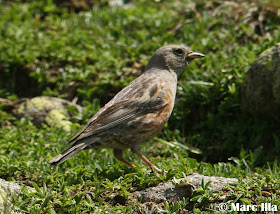July is known as the hottest month, specially in lower areas inland Catalonia. Here, where I live, at 11 o'clock we usually have 30ºC and birding is starting to be a little bit hard. Also, there are only a few 'stimulating birds' these days: the main part you could see are common breeders easy to find everywhere. But in this hot dry lands, shrublands and harvested fields, lots of birds are waiting for being observed.
I decided to prepare some 'ringing stations' in different places (dry lands, maquis shrublands, burned areas and Pinus halepensis and P.pinea forests) around my village, in order to ring and do some birdwatching in different habitats and know a little bit more my neighbours. Although it has been quite hard (very high temperatures, lots of flies and mosquitos, burns...), I'm very happy for the obtained results and still more because of the interesting birds that I trapped.
The
Western Orphean Warbler (Sylvia hortensis) is the greatest
Sylvia Warbler here, but probably the shyest one too when it isn't very common. I trapped this female in a place where I had never seen this species. She had a well-developed broodpatch, but could also be sexed by the head colours and iris.
On the other hand,
Woodlarks (Lullula arborea) are more adaptable and start to breed when first trees grow and can continue breeding when the forest is 'fully grown'.
Crested Larks (Galerida cristata) sometimes appear in burned areas, but is a scarcer bird and only appear if there are consolidated populations near (they use to live in agricultural areas).
 |
| Woodlark (Lullula arborea), juvenile |
 |
| Crested Lark (Galerida cristata), juvenile |
All this species don't have spectacular plumages, so let's see the authentic summer colours:
'
Orange' is a recurrent colour these days, specially in growing forests and maquis shrublands.
Stonechats (Saxicola rubicola) breeds there, where usually
Woodchat Shrikes (Lanius senator) breeds too.
 |
| 2cy (EURING 5) male Woodchat Shrike. |
 |
| 3J Stonechat, putative male (5 white GCs). |
 |
| 3J Stonechat, putative female (only white in innermost GC). |
 |
| 2cy (EURING 5) male European Stonechat |
'
Yellow'.
Golden Orioles (Oriolus oriolus) are
very beautiful birds but a little bit screamers. Aging and sexing them is a little bit difficult but very interesting... As interesting that deserve another post!
 |
| 3+cy female (EURING 6) |
'
Blue'.
European Jays (Garrulus glandarius) hide an spectacular blue design. They can be also quite tricky birds to age, but I think it could be easy with some practise. It's important to look carefully the number of black bars in the outermost GC and the bars design in primary coverts. Also, the colour on secondaries (deep black or greyish-brown) and the width of the outermost rectrice could be used as ageing features.
 |
3+cy (EURING 6). Secondaries are deep black, it seems that
there is a moult limit but its just the difference between primaries
and SS. Primary coverts with parallel and well-marked
black bars, and outermost GC with 10 bars. |
'
Green'. In this last
post, I told about 'late June's migration', and I mentioned a
Green Woodpecker (Picus viridis) as an example of non-breeders that appears in areas where is not a common breeder. Well, after that non-breeder, I also saw and trapped this
juvenile, that had decided to come to
l'Aiguamoll de la Bòbila while it's moulting primaries. Good choice! ;)
'
Mixture': the
Bee-eater (Merops apiaster) is
probably one of most coloured birds in Europe. This feature makes it very beautiful and it'll be always a very special bird.
Ageing is quite easy. 1w birds retain primary coverts in its winter moult in Africa, so when they are back to Europe as 2cy birds, they are recognisable because of that. In spring and early summer, 2cy's primary coverts are blue, without the green tone present in alula and primaries. So that bird was clearly an EURING 5.
Sexing by plumage characters could be easy (as in that bird), or a little bit confusing. If you have any doubt, you should leave the bird unsexed.
 |
| The brown in secondaries should be more extensive in a male... |
 |
... and GCs should not have this green border. Also, in a typical male,
more GC and also median coverts are totally 'chestnut'. |
 |
Also, the mantle have some green feathers. A male should show
more intense yellow feathers and no (or only a bit) green. |
But the bird I've enjoyed the most in the last weeks is not famous for its colours, but its spotted design and specially its texture are quite attractive too. I'm talking about the
Little Owl (Athene noctua).
Juvenile Little Owls undergo
partial moult, affecting head, body and some wing coverts. They retain primaries, secondaries, inner GCs and also primary coverts. Then, in the second calendary year, Little Owls undergo complete moult after breeding. Thus, that bird was a
3+cy (EURING 6), because there wasn't any contrast between wing feathers.
Sometimes, Little Owls leave unmoulted some secondaries in its complete moult. Then, sometimes it's possible to see two generations of secondaries. If there is strong contrast between two generations, the bird should be a 3cy (EURING 7) (because retained feathers are still juvenile), and if there is only a soft contrast, it should be a 4+cy (EURING 8). In autumn, contrast between two secondaries mean EURING 5, and soft contrast, EURING 6.

















































